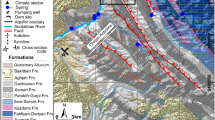Abstract.
Unnaturally steep hydraulic gradients below foundations or across abutments of dams may cause solutional widening of fractures in karstifiable rocks of carbonates or gypsum. This could cause increasing leakage which may endanger the performance of the construction. To investigate this problem recent models on natural karstification have been applied. We have performed numerical simulations of leakage below a model dam with a grouting curtain reaching down to 100 m below its impermeable foundation of 100 m width. Water is impounded to a depth of 100 m. The dam is located on a terrane of fractured rock dissected by two perpendicular sets of fractures with spacing of 5 m, and with a log-normal distribution of their initial aperture widths of about 0.02 cm. In the first state of karstification these fractures widen slowly, until a pathway of widened fractures below the grouting has reached the downstream side with exit widths of about 1 mm. This causes a dramatic increase of leakage, and turbulent flow sets in. After this breakthrough at time T, in the second state of karstification, dissolution rates become even along these fractures and cause widening of about 0.1 cm year–1 for limestone, and at least of 1 cm year–1 for gypsum. This leads to an increase in leakage to excessive rates within 25 years for limestone, but only 5 years for gypsum. We have performed a sensitivity analysis of breakthrough time T for the various parameters which determine the problem. The result shows breakthrough times in the order of several tens of years for both limestone and gypsum. We have also modelled leakage to caves or karst channels 200 m below the bottom of the reservoir, which could induce the formation of sinkholes. The model can be extended to more realistic settings. In conclusion, our results support the prediction that increasing leakage at dam sites can be caused by recent karstification which is activated after filling the reservoir, possibly leading to serious problems within its lifetime.
Similar content being viewed by others
Author information
Authors and Affiliations
Additional information
Electronic Publication
Rights and permissions
About this article
Cite this article
Dreybrodt, .W., Romanov, .D. & Gabrovsek, .F. Karstification below dam sites: a model of increasing leakage from reservoirs. Env Geol 42, 518–524 (2002). https://doi.org/10.1007/s00254-001-0514-7
Received:
Accepted:
Issue Date:
DOI: https://doi.org/10.1007/s00254-001-0514-7




